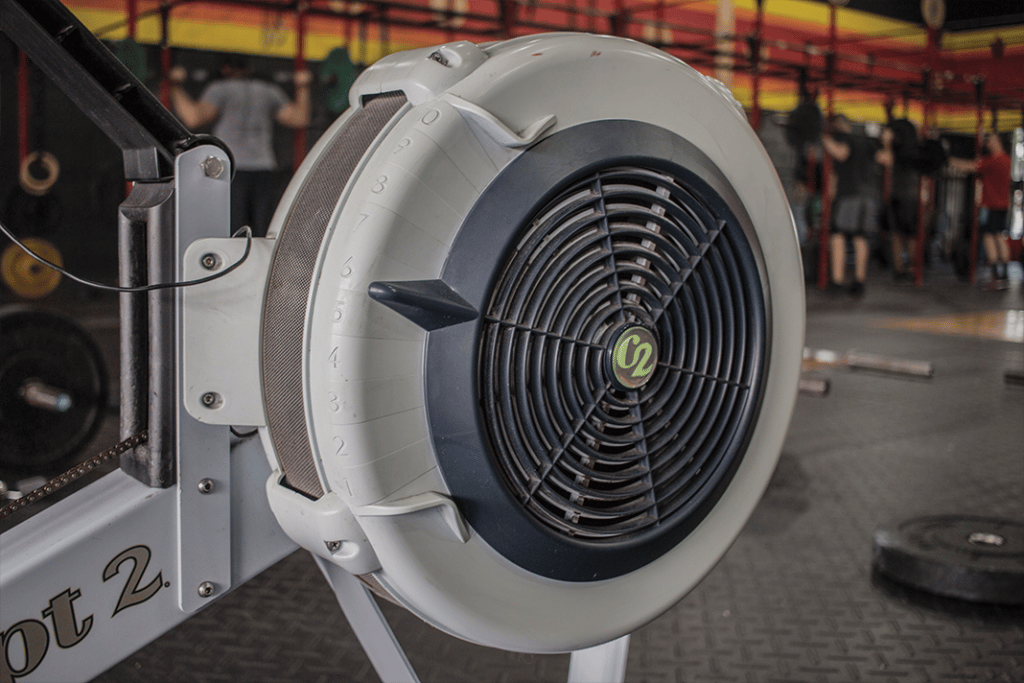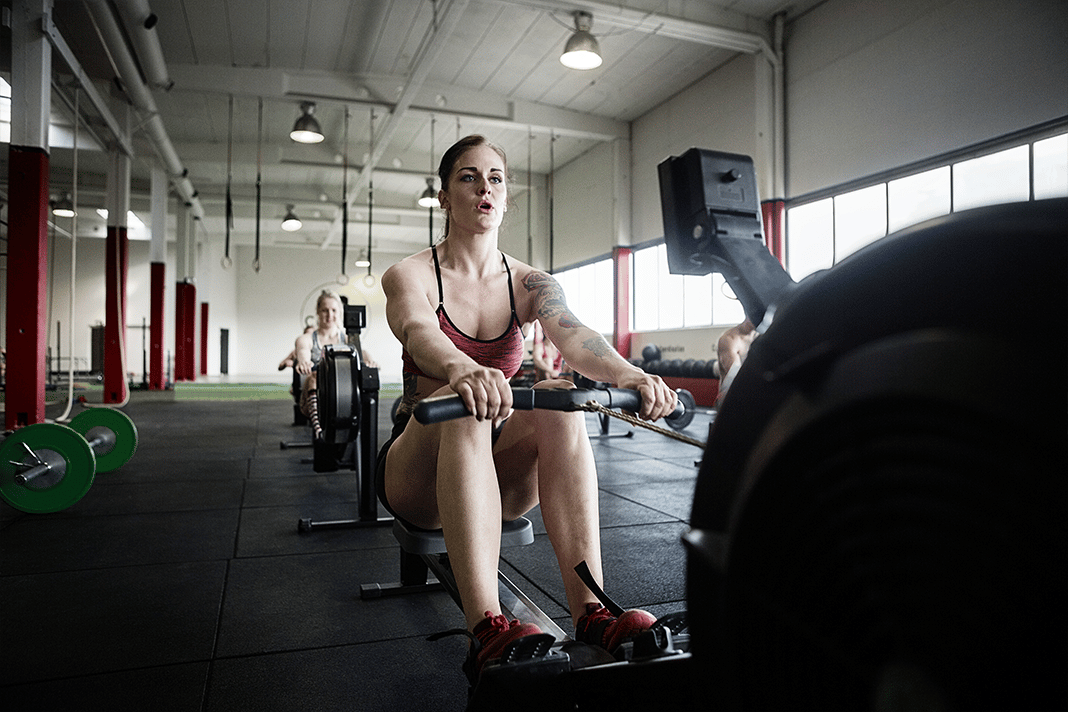Strap yourself in, grab the handle, and go. For a lot of athletes, that’s the extent of their relationship with the rower. Despite the fact that rowing is an integral part of many CrossFit workouts, athletes just don’t spend the time getting to properly know the erg, the indoor rower. In truth, the erg is a highly developed machine meant to replicate the effects of rowing on water, which is why elite rowers train on it during their off season. And when they do, they make sure to take several different factors into consideration—depending on the goals of their program. For us, these factors translate into numbers—three numbers that relate to three factors that can have a profound impact on your rowing performance in any given workout.
The Damper Setting

What is it?
On the side of the flywheel housing (the big circular fan cage at the top of the rower), there is a lever that can be moved up or down. This lever adjusts how much air flows into the cage. The fan cages are usually numbered 1-10; the higher the number, the more air that flows into the flywheel housing, making it harder to spin the flywheel with each pull. Lower damper settings allow less air into the flywheel housing, making it easier to spin the flywheel.
Why It’s Important
Sometimes athletes incorrectly assume that a higher damper setting equals a tougher workout—or that they’ll row at a faster pace because of it. In reality, the difficulty of your workout, or the pace at which you row, has more to do with you with than the damper setting. When rowing at a high damper setting, you move slower up and down the erg so you’ll need to apply more force with each pull to go faster. At a lower damper setting, you’ll have much less air flowing into the flywheel. Because of this, you’ll be able to move up and down the erg faster without applying as much force per stroke.
So, where do you set your drag factor? Think of it this way: Over the course of any given distance, would you rather apply more force with each pull or pull more while applying less force with each stroke. Although you might have an idea of which is better for you, it’s best to take a scientific approach and experiment with different damper settings to find your sweet spot. Start with a damper setting of 3-4 and see how that feels. What pace were you able to keep over the course of 1,000 meters? Retest rowing 1,000 meters at different settings to find which damper setting is more ideal for you.
Pace (in Meters)

What is it?
When rowing, your pace is identified by how long it takes you to reach a certain distance. We’ll discuss pacing using meters, although you can also use calories. On ergs your pace is expressed as time per 500 meters. For example, a 2:30 pace means that it takes you 2 minutes and 30 seconds to complete 500 meters. Depending on the format of your monitor setup, your pace is usually be found between your overall time and meters rowed (as pictured above).
Why It’s Important
Knowing your 500m pace allows you to control the speed at which you row—depending on the distance you need to hit. For example, let’s say a workout calls for you to row 1,000 meters. Assuming you already know that your fastest 500 meter row is 2:30, it doesn’t make much sense to assume you can hold that pace over 1,000 meters. A better strategy would be to lower your pace in the first 500m and gauge how you feel during the second 500m. If you feel strong, you can increase your pace accordingly. Through repeated practice of this method, you’ll find your optimal pace for different distances.
Stroke Rate

What is it?
Your stroke rate is the number of strokes (pulls) you take on the rower per minute, or SPM. Technically, each time you pull on the handle the performance monitor will register a stroke. Depending on your monitor setup, your stroke rate can be found at the bottom left of your monitor (as pictured above).
Why It’s Important
Just like with rowing at a higher damper setting, athletes may incorrectly assume that the higher their stroke rate, the better the workout—and/or the more meters they’ll accumulate. Unfortunately, this just isn’t the case.
For example, let’s take two rowers of equal height and build who are both rowing 1,000 meters. Both rowers are moving at an equal pace of 2:30/500m and have the damper set at 5. However, Rower A has a stroke rate of 40, while Rower B has a much lower stroke rate of 28. This means that Rower B is able to generate the same amount of power in 28 strokes per minute as Rower A does in 40 strokes, making him/her a more efficient rower; generally speaking, this boils down to technique.
Watching your stroke rate is also important for maintaining consistency and control in your row. Let’s say you’re shooting for a five minute 1000m row. For the first 500m you’re able to maintain a 2:35 pace at a stroke rate of 28s/m. As the second half of the 1000m row approaches and fatigue sets in, it’s likely that you’ll subconsciously begin to move up and down the erg at a slower pace. Keeping an eye on your stroke rate and ensuring you maintain it around the 28s/m range is crucial in helping you maintain your desired pace. If you notice your stroke rate dropping, it’s likely that your pace will also drop.
The demands of the WOD may dictate whether you keep a high or low stroke rate during your row. If you need to perform heavy cleans right after your row, perhaps it’s better to use a higher stroke rate with a lower damper setting (which will place greater emphasis on your aerobic capacity). If you want to use the rower to lower your heart rate, consider using a slightly lower stroke rate with a higher damper setting. Just remember, it’s about finding a stroke rate that you can maintain for the duration of the row, and leaving enough energy for the next movement in the WOD if needed.
Bonus: Don’t Forget the Drag Factor
Drag factor is a numerical value that represents the rate at which the flywheel slows down. The higher the damper setting, the more quickly the flywheel decelerates. Therefore, the higher the damper setting, the higher the drag factor. So, why should we worry about drag factor when we already know where to set our damper? Well, various factors affect the amount of air that flows into the flywheel including temperature, dirt on the flywheel, and wind, to name a few. That means that setting the damper at 5, for example, may feel slightly different on each rower you sit on. Drag factor helps adjust for the various factors that affect air flow into the flywheel.















